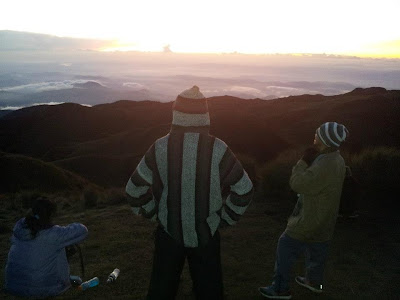From the Camping Area at Camp 2, it took us approximately two hours to reach Mount Pulag's summit, and we were fortunate that the sun hasn't rose yet when we reached the peak. A lot of people told me that a Mount Pulag climb will not be complete if you missed the sunrise so our team was, indeed, lucky because we didn't miss it. Here are the photos taken before and after our "peak pursuit:"
![]() |
| That's me! How does it feel to be 2922 meters above sea level? Priceless! As the highest mountain in Luzon, Mount Pulag attracts a lot of mountain climbers. Highlights of the climb include the montane forests and the grassland summit with its "sea of clouds" phenomenon. There are four major trails up the summit: the Ambangeg, Akiki, and Tawangan trails from Benguet and the Ambaguio trail from Nueva Vizcaya. These trails are managed by the Mount Pulag National Park, under the Department of Environment and Natural Resources. The National Park is inhabited by different tribes such as the Ibalois, Kalanguya, Kankana-eys, Karao, Ifugaos and the Ilocanos. (Source: Wikipedia.) |
![]() |
| Let's go wacky! The conquerors: Jonathan (front), back (l-r): Yours truly, Coach Ceejay, Diarie, Theresa, Carter, Sheela, Beverly and Donna. On February 20, 1987, a large part of Mount Pulag was designated as a National Park with Proclamation No. 75. This act aims to preserve the environment around the mountain due to threats from increased development such as conversion to agricultural lands, timber production, hunting, and increased tourism. (Source: Wikipedia.) |
![]() |
| That's me before the sunrise! Mount Pulag hosts 528 documented plant species. It is the natural habitat of the endemic Dwarf Bamboo, (Yushania niitakayamensis) and the Benguet pine (Pinus insularis) which dominates the areas of Luzon tropical pine forests found on the mountainside. Among its native wildlife are 33 bird species and several threatened mammals such as the Philippine Deer, Giant Bushy-Tailed Cloud Rat (“bowet”) and the Long-Haired Fruit Bat. (Source: Wikipedia.) |
![]() |
| Hide and seek! In this photo: Diarie, Coach Ceejay, Carter, Sheela, Yours Truly, Jonathan, Theresa and Donna. We were "hiding" from the sun. Joke. |
![]() |
| Sunrise is "almost there." In this photo: Yours truly, Theresa, Beverly, Carter, Jonathan and Donna! This is one of my favorite photos taken at the summit. |
![]() |
| In this photo: Donna, Beverly, Carter, Yours truly and Sheela. Because of its high elevation, the climate on Mount Pulag is temperate with rains predominating the whole year. Rainfall on the mountain averages 4,489 mm yearly with August being the wettest month with an average rainfall of 1,135 mm. Snow has not fallen on its top in at least the past 100 years. (Source: Wikipedia.) |
![]() |
| Waiting for the sunrise 2922 MASL. In this photo: Donna, Carter and Yours Truly. Mount Pulag is the only place that hosts the 4 Cloud Rat species. It has one of the most diverse biodiversity of the Philippines, with the newly found (since 1896) 185 grams Dwarf cloud rat, Carpomys melanurus, a rare breed (endemic to the Cordillera) and the Koch pitta bird among its endangered denizens. (Source: Wikipedia.) |
![]() |
| Sunrise at Pulag - the most amazing and the most beautiful sunrise I've ever seen! |
![]() |
| On our way back to the campsite. Big, big thanks to Theresa for the photos! |
We stayed at the summit for approximately one hour and we trekked for another two hours going back to the camping area. The climb was fantastic and, like I always say, it's worth-blogging for. When we went back to the tourism office, I tried "top load" and it was definitely awesome! Imagine a two-hour bumpy ride on top of a jeepney? Well, it takes some balls to do it! Fortunately, I've got some balls - literally and figuratively speaking.








